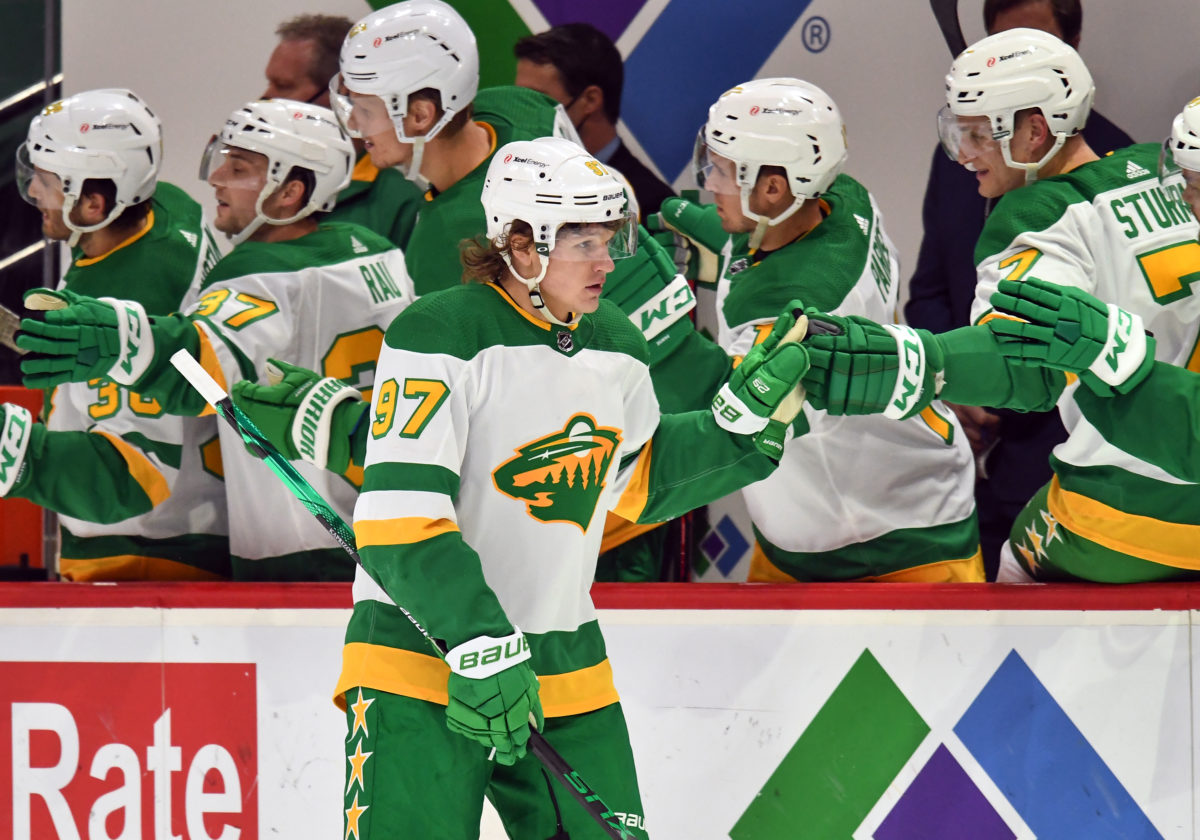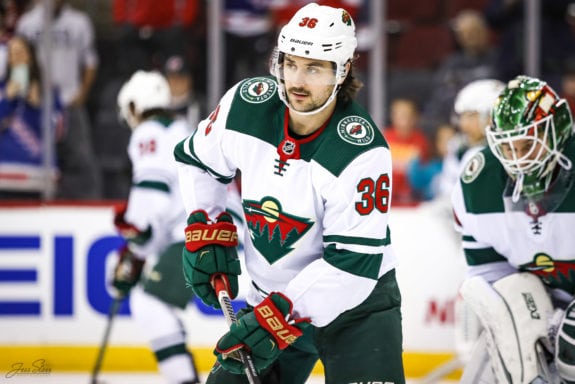The Minnesota Wild have scored 126 goals this season which ranks 12th league-wide. This is surprising given they have had the worst power play in the entire league for a majority of the season but displays how strong they have been at 5-on-5. It seems like a good time to analyze the Wild’s path to scoring; the shot types they utilize to score, the locations they score at more often than others, and the places they exploit the opposing goaltenders to score.
I went back and watched every goal the Wild have scored this season aside from empty net and shootout goals which really don’t provide much insight into their play. This leaves us with 119 goals that we can analyze to uncover patterns, trends, and tendencies into their stylistic offensive approach.
This was inspired by Jesse Granger of the Athletic who did this exact same project for the Vegas Golden Knights (‘Golden Knights Film Study: How are the goals being scored, and from where’, the Athletic, 04/05/2021). It is a very interesting project that can provide valuable information into how a team scores goals.
I tried my best to stay consistent and record information as precisely as possible. With this being said, regardless of its level of perfection, it displays valuable information on patterns and trends that occur this season up to this point in time.
Shot Type
Breakdown of the Wild’s goals by shot type, which shots are being used the most, once in awhile, and the least?
| Shot Type | Goals Scored |
| Wrist | 67 |
| One-Timer | 11 |
| Rebound | 20 |
| Deflection | 11 |
| Backhand | 7 |
| Deke | 1 |
| Slap Shot | 2 |
It shouldn’t be much of a surprise that the wrist shot is used the most as it is the most oft-used tool in a player’s arsenal. It still speaks volumes and is a testament to their finishing ability that has surprisingly been respectable this season despite losing core pieces that excel in that facet of the game. They have generated an extensive amount of their goals utilizing the wrist shot from in the dirty areas and from distance alike.
It might be surprising that it accounts for just over 56% of the Wild’s goals, albeit given the structure of the forward corps, it is not surprising in the slightest. Aside from Kaprizov and Fiala, the high-end talent is missing on the team which is an indicator of why shot types such as one-timers are so low because of the lack of firepower and the ability to set up those types of plays.

Aside from the wrist shot, the other shot types are all used at roughly the same rate with the exception of rebound goals that are the result of their stylistic play. The deflections and backhands account for roughly 9 and 17% respectively which was interesting and lower than expected.
One reason why there haven’t been many slap-shot goals – or attempts for that matter – is that most of them were also one-timers too.
Matt Dumba has the sole deke goal of the season for the Wild when he scored this nice overtime winner against the Los Angeles Kings.
Again, this is somewhat due to the core of the team who tend to have the pass-first mentality or just don’t have the capability to do so. Likewise, the lack of dekes this season isn’t an outlier, the Wild just haven’t had the players to make these plays.
Zuccarello has shown his ability to deke in the shootout but that hasn’t occurred in regulation. Fiala and Kaprizov alike have the ability, but a vast majority of their goals have come from wristers from the slot or circles or other ways aside from a deke.
Shot Location
Breakdown of the Wild’s goals by shot location, where do they score the majority of their goals?
| Shot Location | Goals Scored |
| Slot | 22 |
| Doorstep | 52 |
| Right Circle | 15 |
| Left Circle | 25 |
| Point | 5 |
There is no doubt that the number of goals scored from the slot is fewer than the league average. Their 22 goals scored from this key area on the ice is roughly one goal every other game which just isn’t enough. It further displays the Wild is more of a perimeter team as they also don’t generate a ton of high-danger chances.
The Wild have scored a majority – nearly 44% – of their goals on the doorstep. The doorstep being the blue paint and the area that surrounds it. This is due to a plethora of reasons including deflections, tips, finishing rebounds, and collecting passes right in front of the net that directly leads to goals.
This is a testament to the Wild’s identity as they have to overcompensate offensively – due to the lack of high-end talent – by scoring goals in the dirty areas. Nearly half the goals have been scored within feet of the blue paint and a considerable amount is from the bottom-six forward corps.
Zach Parise has displayed signs of regression this season and as a result, these goals scored from the dirty areas have come from different players, albeit most of his goals this season have come from the blue paint this season. The bottom-six has been incredibly effective this season – with and without the puck – and their forechecking and aggressive stylistic approach has reaped benefits in the form of these goals being scored near the blue paint.
When it comes to scoring in the face-off circles, their tendency is to score goals from the left circle rather than the right. This has become a very interesting trend this season as Zuccarello and Brodin among others have used this as their main source of scoring.

The Wild haven’t scored much from the point and a contributing factor to that is that the defenseman have done a good job at getting up into the play offensively and generating more shots – and goals – from the circles.
Finishing
Breakdown of the Wild’s goals by finishing, where are they shooting and scoring most of their goals past the opposing goaltender?
| Finishing Areas | Goals Scored |
| High Glove | 40 |
| Low Glove | 15 |
| High Blocker | 26 |
| Low Blocker | 11 |
| Five-Hole | 15 |
| Extra W/O Goalie | 12 |
There is a clear tendency from the Wild in terms of their shot placement on goals. They score the most by shooting high glove and it the clear leader among the shot locations. Roughly 33% of their goals are scored high glove on the opposing goaltenders. This would be surprising without context, but it isn’t shocking at all because Fiala and Kaprizov alike have exploited goaltenders by shooting up high, specifically on the glove side.
This is a perfect example with the first two goals being glove side and upstairs.
The Wild spread the wealth when it comes to finishing. The second most popular placement for the Wild is high blocker which displays their tendency to shoot up high on goaltenders. Aside from those two most commonly utilized areas, they do a good job at scoring the rest of the places pretty evenly. Five-hole and low glove are the next two highest-scoring placements, both accounting for nearly 13 percent of their goals each.
Low blocker is a placement that hasn’t been scored on very much. The biggest surprise was the ‘extra without a goalie’ category which is goals that were scored with the goalie out of position. This would include goals that were scored with the goalie out of the crease or at the top of the blue paint. These goals were either tap-ins or goals scored behind the goalie in the crease and such. This can be correlated to their strong net-front presence and scoring in the dirty areas.
How Does This Differ in Comparison to the Vegas Golden Knights?
There are several similarities and differences between the Wild and Golden Knights offensive approaches. First, they both score a ton of goals on the doorstep due to their net-front presence. Both teams score a considerable amount of their goals in tight. Another similarity is that their most-used placement is high glove.
However, the differences are evident. The Golden Knights score almost as many one-timers as wrist shots which speaks volumes. This is a distinct difference between both these teams’ processes. This is a driving force behind why the Golden Knights are such an offensive powerhouse and able to exploit the opposing teams. Likewise, it also makes it more difficult for goaltenders as one-timers are hard to stop.
The second biggest difference is the location where the Golden Knights score the most. Their most commonly utilized location is the slot which is another reason why they are one of the best offensive teams in the league.
Final Thoughts
It is pretty clear how the Wild are scoring goals when breaking down their goals by shot types, locations, and finishing. It provides valuable insight into their offensive approach and how it leads to goal scoring. It will be interesting to see if these patterns continue throughout the rest of the season. There are still areas that the Wild need to improve on including scoring more goals in the slot.
The most important thing is that the Wild continue to score their goals by strong finishing and scoring in tight as that has been the biggest factor in their success so far this season.